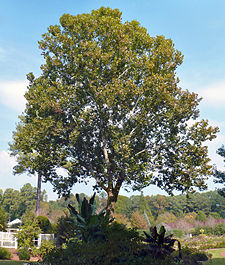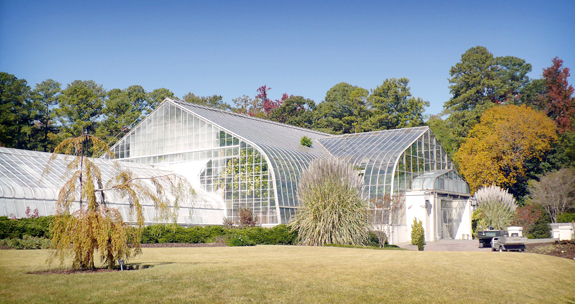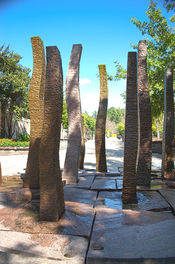Birmingham Botanical Gardens
The Birmingham Botanical Gardens is a 67.5 acre botanical park located in Lane Park between Cahaba Road and Lane Park Road. The gardens, which are free for visitors every day, are owned by the City of Birmingham and managed by the the Friends of the Birmingham Botanical Gardens (originally the Birmingham Botanical Society). The executive director is Tom Underwood. In 2008 an estimated 350,000 people visited the gardens, making it the state's single most-visited free attraction.
The Botanical Gardens encompass 20+ specific garden areas, of which the Rose Garden, Conservatory, and Japanese Garden are most well-known. The botanical collections include over 3,000 taxa of plants. The visitor's center includes an extensive horticultural library, an education center, gift shop, conference rooms, offices, and the Gardens Café restaurant. Numerous events are scheduled at the gardens throughout the year, of which the semi-annual plant sales are the best-known.
History

The idea of creating a botanical garden was the idea of Mayor Jimmy Morgan, who commissioned a master plan for a garden attraction on the present site from Henry Teuscher, curator of the Montreal Botanical Gardens in 1960.
The centerpiece of Teuscher's plan was a 300-foot long greenhouse conservatory reaching 33 feet tall at the center. The mayor tapped architect Charles McCauley to develop plans for constructing the conservatory as the first phase of developing the gardens.
After a fight with the Birmingham Park and Recreation Board, Morgan was able, in the fall of 1961, to establish the Lane Park Committee to act as trustees for the park's creation. Wilborn Construction Company submitted the winning bid for construction and the $161,000 conservatory was opened on December 18, 1962 with Frank Wagner as superintendent and Carl Mattil as director of horticulture.
The next spring, a 26-foot diameter floral clock was donated by Mrs Horace Hammond for the slope in front of the conservatory. The first plant sale took place that May. In the fall of 1964 the board created a membership organization, the Birmingham Botanical Society to maintain and develop the gardens. The Society immediately began working on other elements of the master plan.
In 1965 the annual Sidewalk Art Show was relocated from Woodrow Wilson Park to the gardens. That December a 30 foot by 70 foot pool with an illuminated fountain was installed below the floral clock.
The same year, a major project to create a Japanese-style garden was commenced. Working with several patrons, architect Darcey Tatum engaged Japanese-American architect Masaji "Buffy" Murai to create a garden design for the 7 1/2-acre triangular end of the park closest to Mountain Brook Village. The opening of the new attraction, on May 6, 1967, was attended by the Japanese Ambassador to the United States and was accompanied by the Birmingham Festival of Arts Salute to Japan.
In 1969 the "Touch and See Nature Trail" for visually-impaired visitors was opened. A Dogwood and Lily Garden and Iris Garden were developed the following year. Other improvements that year included irrigation for the Japanese Gardens and various utility upgrades.
In 1971, in anticipation of the Birmingham centennial a new modern expressionist Garden Center, designed by McCauley, was constructed. A crape myrtle garden was also established, reflecting its designation as the city's official flower.
In February 1977, the Moon Tree, an American sycamore grown from a sapling that orbited the moon aboard Apollo 14, was planted near the entrance plaza.
The music video for Amy Grant's "She Colors My Day" was filmed at the gardens in 2008.
Current plans
The Birmingham Botanical Gardens contracted with Oasis Design Group of Baltimore to prepare a master plan for future improvements to the gardens. The plan, completed in 2010, calls for enlargement of the conservatory, creation of a Persian garden, expansion of the Bruno Vegetable Garden, and a reworking of the Alabama Habitat Garden to focus on conserving rare and threatened native plant species. As part of the planned work, steps would be taken to capture more rainwater for use in irrigation and to make the site more easily navigable by visitors with disabilities.
Due to fears of structural deterioration, the glass conservatory was closed to the public in 2011. Restoration and upgrades to the building were begun in early 2013.
References
- "Several additions planned at Botanical Gardens" (December 1969) The Birmingham News
- Satterfield, Carolyn Green (1999) The Birmingham Botanical Society: A Brief History. Birmingham: Birmingham Botanical Society. ISBN 0-9669670-1-1
- White, David (August 31, 2008) "Alabama home to several trees grown from seeds that orbited the moon." The Birmingham News
- Williams, Roy L. (March 3, 2009) "Space & Rocket Center tops list of state attractions, tourism agency says." The Birmingham News
- Spencer, Thomas (March 25, 2010) "Botanical Gardens plans to add Persian garden, enlarge conservatory for forest and desert displays." The Birmingham News
External links
- Birmingham Botanical Gardens website
- Birmingham Botanical Gardens group on flickr.com

